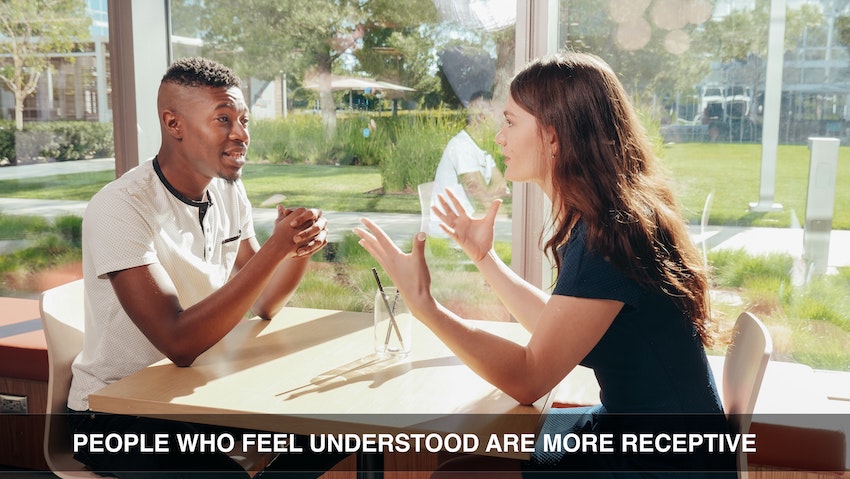How To Handle Resistance And Negativity In Meetings
Turn Negativity into Synergy
Refine your communication skills by learning to harness your emotional intelligence with one of the UK's most acclaimed management training courses.
Why Choose This Training?
More Than Just A Course Of Lectures
What gets in the way of developing and holding on to new communication skills are old habits of thinking and speaking. Even if the advice is very good the reason why it rarely sticks are the mental habits people inevitably revert to, especially under pressure.
Unlearning those old habits and internalising a more effective and lasting approach to communication needs more than a short course of lectures on how to do it.
What Makes This Training Stand Out?
What makes this training stand out is the exceptional support through one-to-one coaching sessions and continuous feedback. Changing behaviour is not an easy task as old habits are hard to break.
With a 40-year track record we can help you cultivate practical skills, and build your confidence to so you can successfully navigate real-world challenges, ensuring lasting behavioural improvements.
Testimonials
Join thousands of participants getting results
"What I love about this course is that I didn't just learn about the topic, this course is about ME. I'm confident I can reliably use my new skills, even when under pressure".
![]()
"A lesson for life! The power of effective communication is incredible when one masters the skills "listening with empathy" and "speaking assertively"
![]()
Clients We Have Worked With
Well-known companies who have used this course again and again, over many years
Course Summary
Training Objectives
This course is designed to help you develop your ability to run meetings successfully. Introducing change or new ideas in a meeting can be hugely challenging. Not everyone is open to new concepts, and resistance from participants can halt progress instantly. Even changes that are necessary and beneficial for the organisation may encounter resistance or negative feedback from employees.
Thankfully, there are ways to manage this resistance so your team can move forward with implementing the proposed changes. On this training course you’ll learn about proven methods of handling resistance and negativity in meetings, empowering you to successfully introduce beneficial changes that benefit people around you with confidence.
You’ll be able to Identify the root causes of resistance and negativity such as personal issues, lack of communication or clarity, or fear of change. You’ll learn how to establish trust through open communication by actively listening and understanding each participant’s point of view. You’ll be able to create a supportive environment in meetings by setting expectations, leading with empathy and positive reinforcement rather than punishment. You’ll develop your ability to lead with empathy so you can better build an atmosphere that encourages creativity while preventing blain-storming sessions from occurring during discussions.
Develop Your Emotional Intelligence
You will learn a set of powerful emotional intelligence communication techniques so that you can manage difficult conversations, handle challenging situations, build relationships and set firm boundaries.
Transferable Skills
The goal of this training is to equip you with the tools they need to build strong, lasting relationships in your professional life, although because these skills are so transferable many clients report vast improvements in their personal relationships as well.
Develop Skills
This is a skills development rather than just a theoretical programme, so the emphasis throughout will be on you taking turn after turn, practising your skills, while receiving feedback and coaching about your effect on others.
Repeated Practice and Feedback
In your coaching sessions you will be helped to practise dealing with the kinds of situation you find challenging, again and again, until you are confident you can do it successfully.
Video Analysis
We'll combine practical, hands-on experience with video replay and analysis and discussion of the principles involved to help you gain both skills and understanding. Special attention is paid to your individual training needs, so you can practise your skills in real-life situations that you have to handle at work.
Sustained Change
That's why as well as your place in a small group, this training includes a generous amount of private and confidential one-to-one coaching sessions online, spread over several months, ensuring an exceptional level of support. This will ensure the changes you make are sustained over a longer period of time and any obstacles are overcome. Choose between online training available worldwide, or in-person face-to-face courses in the UK.
Course Dates and Price
For a list of upcoming course dates (for online coaching and face-to-face training), the locations of the next 3-day public courses in the UK and pricing Click here.
Free Initial Session
This initial coaching session serves as an introduction to the "Skills with People" course, allowing you to understand the course's relevance and effectiveness for your specific needs before committing to it.

Understanding Resistance and Negativity in Meetings
By examining the reasons behind resistance and negativity, it is possible to understand how these feelings impact productivity and morale in a team or organisation.
Reasons for resistance and negativity
- Poor communication of expectations, goals or objectives by senior leaders
- Changes to job responsibilities or roles
- Ambiguity in the change process or a lack of understanding about how it will affect an individual
- Fear of new skills and technologies that may become necessary for the change initiative
- Job insecurity due to shifts in power dynamics caused by organisational changes
- Fear of failure associated with the change effort
- Unaddressed personal issues amongst employees
- Brain-storming cycles caused by ongoing resistance or negativity
- A sense that people are fighting against a powerful status quo
- Feelings of inadequacy if they are unable to contribute proactively during meetings
Impact on productivity and morale
Resistance and negativity in meetings can have a detrimental effect on workplaces. If left unchecked, this behaviour can spread quickly within a team or organisation and negatively impact morale which in turn could lead to decreased productivity.
Low company morale has been found to dissuade employees from putting effort into their job. On the other hand, when resistance is addressed appropriately, it can result in improved attitudes towards work tasks due to increased employee involvement and buy-in of decisions made during meetings where resistance from negative employees might be present.
Encouraging positive communication instead of conflicts in disagreement should be an integral part of any meeting’s dynamic as studies show that effective communication leads to better outcomes at work.

Identifying Root Causes Of Resistance
It is important to identify the root causes of resistance and negativity so that they can be addressed proactively, usually involving examining personal issues, fear of change or a lack of communication or clarity.
Personal issues
Personal issues, such as fear of failure or the belief that a change is harmful, can contribute significantly to resistance and negativity in meetings. For example, when employees feel their job security is threatened by an impending change at work, it can lead them to react with hostile behaviour during meetings—such as discouragement or eye-rolling—in order to express their discomfort with the situation.
As such behaviours can display dissent and disrupt momentum during conversations, it’s important to address underlying personal concerns quickly and effectively. To do so requires understanding why meeting participants may be resistant or negative in the first place: are they feeling insecure? Do they lack trust? Is there a specific trigger for their reactions? Also essential is creating a supportive workplace culture that values open communication among all levels of leadership—with senior leaders setting expectations for behaviour but also taking into account individual feelings during times of transition.
By developing an environment where each employee feels valued and heard within team discussions regarding changes could help create buy-in from stakeholders while keeping morale high - ultimately enabling successful organisational outcomes even amidst conflicting resistance attitudes.
Lack of communication or clarity
When it comes to meetings, lack of communication or clarity can be one of the main contributors to resistance and negativity. Poor communication in the workplace creates a tense environment and hinders productivity and collaboration.
Individuals may not understand their place or role in organisational changes as well what is expected of them due to ineffective communication. In healthcare for example, a lack of effective communication can have serious consequences - putting patients at risk by leaving critical information absent or misinterpreted.
When staff are unclear about expectations, goals, tasks and roles in projects due to inadequate communication can lead them feel insecure about their job security which ultimately results in resistance to change efforts.
Fear of change
The fear of change in meetings is a common phenomenon that can result in both resistance and negativity. Many people, especially those who are comfortable with the status quo, may either resist change or fear what will happen if changes are made to the current processes or systems.
They may worry about their own job security, will they have to learn new skills or how these changes might negatively impact them. This uncertainty can lead to feelings of discomfort around the proposed change initiative which ultimately causes them to resist it.
For example, when introducing a new technological system into an organisation for better efficiency results in employees feeling uncertain about why this technological change has been done and what it means for their current roles.
Their fears can manifest as anger or even aggression resulting in conversations becoming negative and unproductive leading to a breakdown of morale rather than improvements. It's important for senior leaders and managers to identify these root causes early on so they can address the issues proactively by establishing trust through empathy and open communication.

Creating a Supportive Environment
Effective management of meetings can further enhance the environment and foster a sense of inclusiveness, leading to better collaboration and improved productivity.
Proper management of meetings
is essential to create a supportive environment and handle resistance and negativity in the workplace. Proper management involves properly setting up meetings, communicating clear expectations, creating ground rules, addressing any negative attitude or behaviour, leading with empathy and establishing positive relationships within the team. Clear communication allows for everyone to express their concerns or ideas without fear of judgement or hostility from others. Furthermore, it can help identify potential issues that might otherwise remain unacknowledged and can lead to better problem solving solutions. Establishing clear roles in the meetings makes sure tasks are appropriately assigned throughout participants while preventing brain-storming sessions between various individuals which may be unproductive or demotivating.
Clear communication and expectations
When it comes to creating a supportive and productive workplace environment, clear communication and expectationsplay an important role. Effective communication between managers and employees can help prevent misunderstandings, improve company culture, promote growth and productivity, as well as maintain healthy relationships in the work environment.
Establishing clear expectations up front can ensure that desired outcomes are achieved with minimal confusion or frustration. Through active listening and open dialogue, senior leaders can set ground rules for meetings from the start – this allows all participants to have their opinion heard without fear of negativity or retaliation.
Clear communication also helps empower your team by allowing them to feel confident when voicing their opinions during discussions while avoiding brainstorming scenarios that often happen in chaotic meetings.
By setting shared goals and understanding each employee’s unique contribution towards those goals allows everyone on board to be more focused on achieving success rather than being entangled in petty disagreements or opposing views across departments.
Empathetic leadership
Empathetic leaders focus on creating a safe and supportive environment where all viewpoints are encouraged and conflict is handled constructively. They understand that things don’t always go as planned but try to maintain a positive attitude despite any turbulence.
As a manager, this means actively listening to staff concerns, being open-minded and encouraging honest dialogueeven if it involves difficult conversations. These leaders can handle anxiety, resistance, and complaints effectively by taking responsibility for mistakes or shortcomings rather than blaming the other person.
Studies have shown that empathetic leaders are more successful in their roles leading to better morale among employees; research from Harvard Business Review also found those with an aptitude for empathy show greater engagement, trust building capacity and efficiency in decision making processes.

Handling Negative Behaviour in the Workplace
Identifying and addressing the root causes of negative behaviour in the workplace can help to form a support system for team members going through personal issues, while maintaining an overall positive morale.
Keep reading to learn more about strategies to manage resistance and overcome negativity in meetings!
Types of negative behaviour
- Hostility or aggressiveness: Such behaviour can undermine a team’s efforts to accomplish projects and goals as well as negatively impact morale.
- Narcissism or lack of accountability or responsibility: Those displaying narcissistic or irresponsible behaviour may take credit for the work of others, offer little in the way of tangible contributions, fail to take blame for mistakes, or make excuses rather than acknowledging their role in any mishaps.
- Rudeness, disrespect, or bullying: These behaviours often arise when employees feel threatened by other colleagues and act out by displaying inappropriately aggressive language or conduct towards them.
- Poor job performance: This could manifest itself in reduced productivity on projects, submissions of work that does not meet expectations, ignoring priority tasks and deadlines, failing to adhere to the standards set by the company’s policies and procedures, and other signs of negligence on the job.
- Not working well with others: Many times employees who are not able to work effectively with coworkers display negative behaviour such as isolationism from team discussions and activities, hostility towards constructive criticism from peers, and avoidance of participating in group decisions related to projects they are part of.
- Resistance to coaching or feedback: Employees who are defensive when receiving feedback typically respond with excuses and justifications rather than acknowledging areas where they need improvement. They may also shut down conversations quickly before all points have been discussed thoroughly enough for successful resolution.

Confronting and addressing behaviour
It is important to confront and address negative behaviour in the workplace promptly, as this can help prevent it from spreading. Ignoring bad behaviour does not make it go away; instead, addressing and confronting inappropriate conduct head-on is essential for maintaining a respectful working environment. In order to effectively deal with such situations, managers should take the following steps:
- Identify specific behaviours that are present or have been reported. Focusing on particular issues will produce a more specific response rather than dealing with generalisations about an employee's attitude or performance.
- Schedule time to talk privately with employees who exhibit these kinds of behaviours and express your concerns directly in writing if necessary. By tackling issues directly but calmly and fairly, it can be easier to get to the root of possible misunderstandings or miscommunication between yourself and the individual concerned.
- Take time during this conversation or subsequent meetings you may schedule with them to explain why their actions were unacceptable – clearly expressing how they broke acceptable standards of conduct at work – yet show respect by letting them know that you value them as an individual employee too who has potentially just become confused by lack of clarity around current protocols involved in their role/workplace overall..
- Encourage a positive dialogue where employees are allowed plenty of space for self-expression without feeling threatened or reprimanded harshly when discussing points on what could’ve gone better ( acknowledging any underlying problems while keeping things constructive moving forward) - noting that mistakes happen so please do learn from past experiences together too!
- Develop goals courses which outline clear strategies on changing certain aspects of behaviour along with achievable objectives set against relevant timelines - Make sure these expectations don't seem overwhelming nor impossible either so agree shorter term objectives first towards bigger picture improvement over course succeeding weeks/months ahead up until targets met altogether).

Strategies for Managing Resistance and Negativity in Meetings
Focus on creating an environment that encourages open dialogue and positive thoughts for overcoming resistance and negativity.
Checking yourself as a manager
When handling resistance and negativity in meetings, it is important to check yourself as a manager. By taking full responsibility of the conversation, you can make sure that the discussion remains productive and efficient.
Self-awareness is key when navigating these challenging situations – take time to reflect on your own reactions and motivations in order to stay focused on problem solving. Additionally, clear communication is essential for creating an environment where all parties feel heard without minimising or dismissing their concerns.
Invite audience engagement by encouraging participants to share their feedback and ideas so that everyone’s views are taken into consideration during decision making process, Moreover, be supportive of individuals who face difficulty with change initiatives by positively recognising them for their effort towards adaptability.
Seeking support
Problems such as resistance and negativity in meetings can have a detrimental impact on productivity, morale and the effectiveness of change initiatives. When handling these issues, seeking support is essential to ensure effective outcomes.
Having the right people involved at each stage of organizational change - from planning, launching to managing - helps bring clarity and alignment throughout any change efforts. Going it alone may also increase fear of failure or lack of direction which can ultimately lead to reduced buy-in from stakeholders affected by the changes.
For example, many studies show that successful transformation efforts involve enlisting senior leadership for ongoing support during implementation stages as well as providing resources towards training employees on new skills or knowledge associated with the initiative.
This ensures everyone not just understands changes but feels confident with their prospects in helping steer an organisation’s new direction forward while allowing them to contribute meaningful solutions that fit within established goals and objectives.
Choosing battles wisely
When it comes to handling resistance and negativity in meetings, choosing battles wisely is a key strategy for managing the situation and creating a more supportive environment. It means that as managers or leaders we have to take into account what are the most relevant issues worth addressing, and prioritise accordingly.
When dealing with workplace issues or challenging individuals, it is important not to tackle every disagreement or conflict head-on as this can become overwhelming quickly. Instead, focus on identifying what truly matters; those issues which will cause long terms effects if left unresolved.
With this approach, tackling disagreements becomes about finding solutions that work best for all parties instead of trying to "win" every battle – ultimately making these conflicts into constructive dialogue that can improve team morale and productivity.
Maintaining a positive outlook
Maintaining a positive outlook is essential for handling resistance and negativity in meetings. It is vital to use positive language instead of drastic words that convey defeat or put-downs.
Being an energised leader can help motivate employees toward achieving a common goal, making them feel more comfortable expressing their opinions and being open to new ideas. It will also foster trust and confidence between team members, thus helping the meeting run efficiently even in the presence of resistance or negativity.
Engaging with employees at every level encourages each person to stay motivated and engaged while improving communication between participants - this not only helps learners understand expectations but promotes ownership of decisions within the group.
Additionally, focusing on points where conversation could be productive rather than asserting authority saves time, lifts morale, and keeps everyone focused on progressing ahead together as opposed to dwelling over issues from before or getting caught up in arguments.

Managing Meetings Effectively
Scheduling meetings strategically, establishing ground rules and roles, checking in with participants and preventing brainstorming are key to managing meetings effectively.
Scheduling meetings strategically
is a key part of ensuring successful and productive meetings. It is important to first determine if the meeting is necessary, only invite people who need to be there, set a clear agenda for the meeting, come up with an appropriate schedule that allows enough time for everyone’s input and tasks while staying on topic and preventing brainstorming. Sharing plans for the meeting ahead of time so attendees can properly prepare can enhance productivity in any given setting. Utilising thoughtful scheduling strategies help foster collaboration and enable each individual in attendance to effectively make their mark or contribute towards the goals of the session. Doing so minimises stress before, during and after the discussion since all key players are included in decision-making processes while receiving what they need going forward.
Establishing ground rules and roles
Setting ground rules and having all meeting participants understand their roles are key components to success in meetings. Ground rules should ensure that everyone respects each other's ideas, establishes trust between the organization and the members, encourages participation from team members, and fosters effective communication. To create an effective set of ground rules:
- Set clear expectations about how people should behave during meetings. This includes assigning a specific time frame for speaking turns or interactions with others so that everybody has equal opportunity to participate.
- Encourage colleagues to be more involved by offering timely feedback or responding quickly once they share comments/ideas during the discussion so as to keep the dialogue moving forward in a productive way without interruption or distraction from irrelevant topics/persons outside of the group setting such as friends, spouses etc..
- Create role distinctions among team members like lead facilitator who ensures smooth running of the session ,or assign secretarial duties – someone taking proper notes important points made throughout–so necessary details can be recorded accurately on behalf of those not always present at every planning gathering .
- Assign an appropriate moderator (leader) who must act fairly &coach effectively when needed - someone assertive but respectful ,who promotes efficient use of limited conversation minutes while encouraging unique perspectives and openness toward divergent opinions being expressed no matter what personal misgivings might’ve existed considering its various sources .
Checking in with participants
Holding check-in conversations at the start of meetings gives everyone a chance to briefly state their current mindset, emotional and mental status within the group. This exercise is essential for any successful meeting as it helps build psychological safety with team members while setting the desired tone for open and honest communication.
Conducting check-ins allows managers to better understand their employees’ needs in order to address any concerns or issues they are facing before moving on with business-related topics.
Moreover, practitioners often find that most of the time when people resist changes or new approaches during meetings can actually be traced back to feeling unheard or misunderstood due to a lack of checking in and exploring individual perspectives from an empathetic place first.
By facilitating quick check-ins right prior or even right after each meeting step - such as planning, taking action items, decision making, etc., effective facilitation skills kick into gear helping direct conversation and active participation accordingly.

Handling Resistance to Change
Expecting resistance to an organisational change is normal, so it should be managed formally with the help of identified resistance managers who can address the issues proactively and ensure ongoing support for change resistance itself.
Expecting resistance
It is important to expect resistance when implementing change in meetings, as it can help managers better manage and address potential sources of negativity. When expectations of resistance are managed proactively, this can lead to more effective and change management initiatives with greater buy-in from senior leaders.
By anticipating that people might be resistant to changes or new ideas, it allows for specific strategies and approaches to overcome resistance to be created before the meeting takes place. Strategies such as involving employees in the decision-making process or providing time for questions and feedback beforehand encourage a sense of participation rather than exclusion which helps create an environment of support throughout the meeting.
By anticipating how people may react at certain points during a meeting about changes being proposed, managers can prepare themselves on how they should handle negative reactions by establishing ground rules or having certain facilitators act should any conflict arise within groups or between individuals. For example, if you can anticipate what people might say you can have your empathy tucked up your sleeve so you can gently offer it when people voice their concerns. When you are able to empathise with their concerns it tends to calm people right down, because most all people tend to enjoy feeling understood. Remember, showing your understanding isn’t the same thing as automatically agreeing with everything they say. You can demonstrate you get where they are coming from, even if you passionately disagree with their point of view. Your empathy can have a powerful calming effect what otherwise might be disruptive and unhelpful behaviour.
Managing resistance formally
Formally addressing resistance can be a valuable way to manage resistance in meetings. By engaging the right stakeholders and developing formal plans, protocols, and processes, it is possible to minimize the overall impact of any potential resistance while being proactive about any changes specific actions that may need to take place.
For example, clear communication strategies can set expectations for both those leading the meeting as well as participants. This helps everyone understand their roles, allowing them to feel comfortable with their contributions and more likely to accept change within the team or organisation.
A sense of job security also alleviates some fears associated with change initiatives that could otherwise prompt negativity or opposition behavior in the workplace. Forming an empathetic management style enables managers to identify underlying issues affecting people's behaviour. If you can uncover root causes of resistance in a positive manner rather than confrontational approach when dealing with negative behaviour in meetings, you can then skilfully support employees who could cause disruption during meetings if you’d not addressed their issues proactively.
Identifying root causes
Identifying the root causes of resistance to change is essential in order to effectively manage it. It helps us understand why some people resist change, and then find ways to address those reasons.
Common causes of resistance include personal issues such as job security concerns, lack of communication and clarityon expectations or goals from senior leaders, fear of change or failure due to lack of knowledge about a process etc. For example, if an employee feels that their job is threatened by a proposed new technology aimed at streamlining processes they may consciously or subconsciously resist it unless their fears are addressed proactively.
If proper support for learning new skills isn’t provided employees may also tend to challenge the initiative out of fear instead of feeling confident in its success. Addressing these underlying issues can help turn negative attitudes into more productive conversations in meetings which will ultimately create collaboration and buy-in for any proposed changes within organisations.
Engaging with the right resistance management attitudes
When managing and handling resistance in the workplace, it’s essential to ensure that the most effective attitude is used to manage other people’s resistance. If tends to work much better if you are entrusted by the people you are talking to with the responsibility of ensuring that any form of resistance to change is addressed proactively and respectfully. Once people have the confidence you’ll effectively manage potential sticky situations in order to achieve success it tends to work ore smoothly than if people view you as a authoritarian who squashes debate and suppresses the slightest hint of decent or bad feelings.
In order to handle people successfully you need to be become adept at engaging employees through communication and providing them with ongoing support, reassurance, knowledge, tools and resources. You need to be able to identify root causes behind employee resistance such as job security concerns or feelings of fear amongst others.
By having a clear understanding of this underlying factor will help create an conducive environment for a successful transition into new opportunities presented by change initiatives while also giving employees an opportunity feel confident and secure about their roles.

Evaluating and Improving
Analysing meeting outcomes and implementing any necessary changes for improvement can help ensure resistance and negativity don't impede success.
Reflecting on meeting outcomes
Reflecting on the outcomes of meetings can be an important step towards understanding how to successfully achieve team goals and work together in harmony. This reflection helps bring awareness to areas of improvement and highlights achievements that have been made by teams during meetings.
It involves assessing the overall experience such as communication, collaboration, problem-solving effectivenesswhich can act as a barometer for improved productivity in future group situations.
Effective reflection also allows individuals to develop transferable skills that can be adapted in similar or different projects going forward. In addition, it provides insight about individual actions helping members understand their own strengths and weaknesses more clearly which would eventually help them make well-informed decisions regarding their professional growth.
Implementing changes for improvement
A successful change effort requires active engagement from employees, management’s clear communication of expectations and vision for organizational changes, and changes that are relevant to the company’s goals. Here are some strategies for implementing effective change:
- Engaging key stakeholders - Ensuring participation of all key stakeholders in the decision-making process is important to ensuring a successful outcome. Senior leaders should explain why the present state needs changing, solicit input about different approaches or solutions, and listen to feedback throughout the process.
- Defining roles – Executives must make sure there is clarity around roles and responsibilities before initiating any project or introducing new initiatives—to ensure every team member knows their part in creating and achieving success with changes. This understanding helps promote enthusiasm among team members as well as minimise resistance due to fear of unknown consequences tied in with making business transitions.
- Communicating clearly - Clear communication between executives and teams whenever changes happen creates an open environment that elevates morale because it promotes transparency abroad while also calming fears about potential adverse effects brought on by those materialising alterations. It also allows opportunities for managers to answer questions from concerned members, which can further be used as an opportunity for education within departments concerning what kind of current operational practices take place within given sectors (knowledge sharing).
- Addressing resistance proactively – Negative response towards transformational efforts can occur when individual employee concerns such as job security go unnoticed or unaddressed. Potential roadblocks can often be anticipated and empathised with. Once people feel understood they are much more likely to listen to any reassurance you are able to offer. You’ll be able to think strategically and tactically by anticipating possible areas certain personnel might fight back against.
- Encouraging positive reinforcement – Employees dealing with organisational changes tend to need support if they feel neglected. Positive feedback, and plenty of nurturing during this unsettling time of change will motivate people to be more willing to accept the inevitability of change.

Conclusion
It is important to recognise and understand resistance and negativity in meetings, as they can have a detrimental impact on overall workplace productivity and morale. By actively planning out meeting agendas that are clear and organised, managers create an environment of boundaries and respect while still allowing for creative input from personnel.
Proactive tactics such as having ongoing support through checks-in with participants during or after meetings, being transparent regarding expectations throughout the change process, engaging employees at all levels in any changed initiatives, implementing positive enforcements across the board rather than punishing corrective action without pause when necessary can all be effective ways to minimise resistance and negativity in meetings.
Managers should remember to lead by example by remaining calm under pressure, maintaining a sense of optimism regardless of how individuals react to presentations or feedback offered during meetings as well as setting up realistic expectations with regards to changes happening within the organisation. Empathy is a very powerful tool that can be very handy in situations like this.
Ultimately if done right managing resistance optimal will require leaders who possess skills that help people feel consulted rather than dictated to. If you’re not quite sure how, let us show you on this course.

FAQs
1. What is resistance and negativity in meetings?
Resistance and negativity in meetings are reactions to the introduction of change, where human beings tend to resist any changes from their current state or current way of life.
2. What are some likely sources of resistance or negative emotions at meetings?
These may occur when introducing new technology, task processes or even policy changes. This creates a daunting challenge for those trying to initiate change, leading to cycles of resistance and counter-resistance within employees.
3. How can I handle employee's resisting and feeling negatively about a meeting?
To overcome this issue try engaging with team members individually rather than group setting as interactions towards higher personnel often invoke feelings of powerlessness leading to negatively fuelled responses during meeting sessions. Aiming for buy-in from staff through open communication promotes trust which rarely fails amidst disorientating transits such as technological advancements or policy changes within work contexts.





















